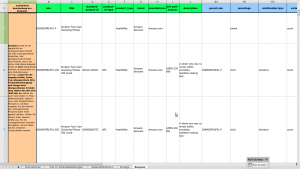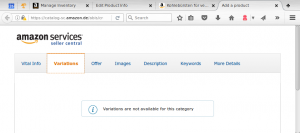Productvarianten (Amazon)
Naar navigatie springen
Naar zoeken springen
The printable version is no longer supported and may have rendering errors. Please update your browser bookmarks and please use the default browser print function instead.
Terminologie
Voor eens en voor altijd: De terminologie die ik gebruik:
Parent of parent-product
Aka. main-product of soms OEM-product.
Child of child-product
Niet: sub-product
Wat het is
Varianten zijn alleen beschikbaar voor specifieke producten, voor specifieke parameters. Bv. vermogen bij lampen [1]
Velden
Amazon gebruikt de volgende velden voor productvarianten:
parent_child (Parentage)
Defines the product within a relationship with another, similar product. The "parent" defines the basic data about the product. Parent products are not purchasable; the "parent" product simply specifies the attributes of the product that are common among all of its children and only acts as a place holder. The "child" products define the possible variations (i.e., size, color) of the parent product and represent the items that are actually for sale. This field is required if any of the following columns are populated: variation_theme, color, paper_size, maximum_expandable_size, line_size. If the product does not participate in a variation relationship, use the value "child." For further information about how to construct a product variation, please refer to this template's "Example" tab.
Toegestane waardes:
- parent
- child
- (none)
parent_sku (Parent SKU)
If the product is a child product, list the SKU of the parent product which is related. DO NOT FILL IN THIS FIELD FOR PARENT PRODUCTS.
- Parent-SKU
- Parentage - met waardes parent, child, of uiteraard niets
- Relationship-type
variation_theme (Variation Theme)
Describes the parameter(s) by which the parent product may vary. The value input for this field should be the same for both the parent and child SKUs. Example: If the product varies by size, input the value Size. If the product varies by color, input the value Color. Terms used for variation themes are created by you the merchant. (e.g. 'count' can be any number that you choose).
Toegestane waardes zijn afhankelijk van het soort product:
Building materials:
- Color
- Gewicht
- ItemPackageQuantity
- Material
- PatternName
- Size-Color
- SizeName
Hardware:
- Color
- Gewicht
- ItemPackageQuantity
- Material
- PatternName
- Size
- Size-Color
Etc.
relationship_type
Toegestane waardes:
- Accessory
- Variation
Kan ik dit ook thuis uitproberen?
Zeker! De casus die ik zelf voor ogen heb:
- Varianten van een bepaald product zijn geoptimaliseerd voor een bepaalde propositie. Het betreffende product is identiek aan het parenteel-product. Alleen de informatie is beperkter
- Deze varianten worden niet als varianten gepresenteerd op Amazon, maar als op zichzelfstaande producten. Ik heb dus niet te maken met de Amazon-productvariant-velden
- In theorie kan ik met overerving werking. Dus dat niet-ingevulde velden van productvarianten, worden ingevuld vanaf het parenteel-veld, maar da's veel te complex! → Gewoon alle velden invullen!
Veld: parent_sku
Ik heb alleen een veld parent_sku nodig - Program today for today, and tomorrow for tomorrow.
Zie ook
Bronnen
- https://sellercentral-europe.amazon.com/forums/thread.jspa?threadID=92359 - Thread: Which categories are eligible for Product Variations? (Parent/Child)

